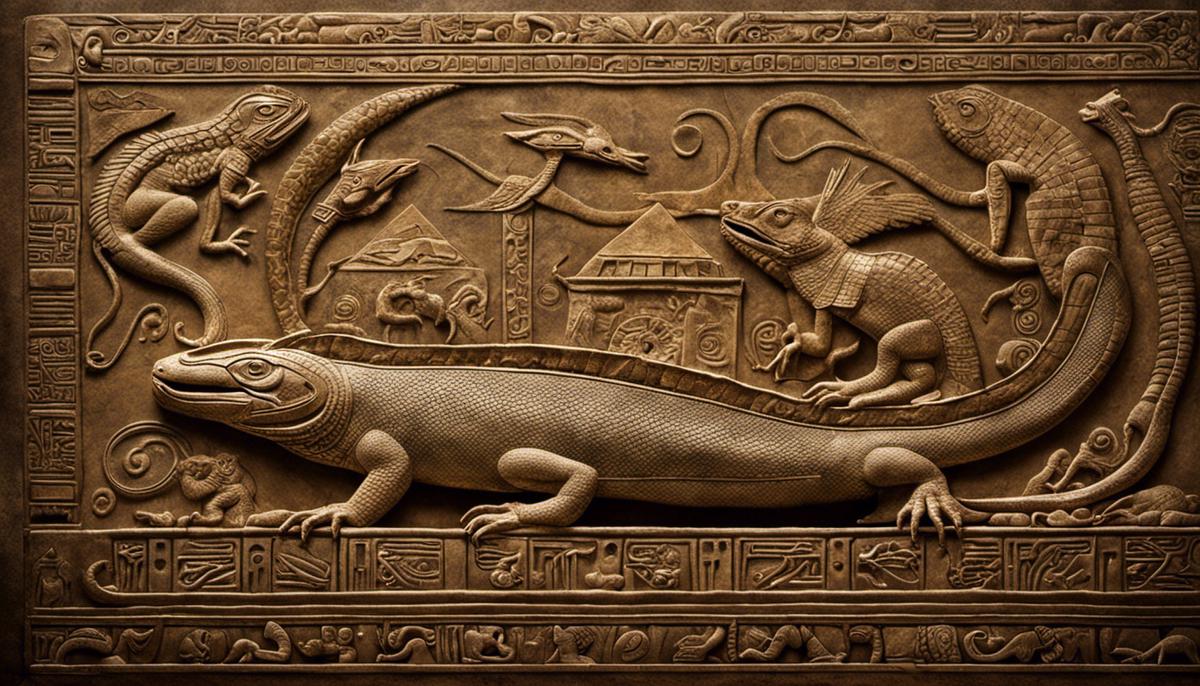Reptiles, over centuries, have imbued our folklore with tales that kindle awe and fear, tales woven from the silky threads of our imagination and elevated to the dimensions of myths and legends. Their mysterious nature and unconventional appearance have forged an indelible imprint on human consciousness, manifesting in stories with varying symbolic significance. From ancient cultures venerating or fearing them to modern interpretations in arts and literature, reptiles have undeniably played a monumental role in the human narrative. This examination unravels the captivating journey of reptiles through the annals of our mythology, casting a discerning eye on the origins, meanings, impacts on modern culture, and truth behind these fascinating tales.
Origins of reptile myths and legends
Delve Into the Past: The Origins of Reptile Myths and Legends
Reptiles are incredible creatures that have inhabited the earth for millions of years, right from the age of the dinosaurs. With their fascinating attributes and distinct characteristics, it’s no wonder they have enthralled humans, becoming the center of countless myths and legends. But one question demands our attention – how did these reptile myths and legends originate?
The origins of reptile myths and legends can be traced back to ancient civilizations. These creatures’ unique traits, such as shedding skin and hibernation, were beyond the comprehension of early humans. This lack of understanding, combined with our ancestors’ natural propensity for storytelling, resulted in the birth of numerous gripping tales. For example, in many ancient cultures, the snake symbolized immortality due to its ability to shed its skin, implying eternal youth and renewal.
Particular geographical locations have also played a significant role in shaping various reptile myths and legends. In regions where reptiles are abundant, they have become an integral part of local folklore and mythological stories. Regions like Australia, Africa, and South America, rich in their diversity of reptiles, have myths galore. The Australian Aboriginal dreamtime story of the rainbow serpent—a colossal snake that shaped the landscapes—is one such well-warranted mention.
The ‘dragons’ seen in various cultures worldwide also represent a compelling aspect of reptile mythology. Surprisingly, this creature found its way into the folklore of diverse cultures, despite significant geographical and cultural differences. From ancient China’s benevolent water deity to the destructive fire-breathing monsters in European lore, dragons have consistently captivated human imagination. Many suspect that the concept of dragons evolved from earlier civilizations stumbling upon fossils of large reptilian creatures, such as dinosaurs. The thought of colossal, powerful beasts generated a blend of fear and awe, eventually translating into tales featuring dragons.
Reptiles have also featured prominently in symbology and iconography across different societies. Ancient Egyptians revered the cobra, featuring it on the crowns of their Pharaohs symbolizing divine, royal power. In Mayan and Aztec cultures, the feathered serpent god Quetzalcoatl was an important deity, representing wisdom and knowledge. Clearly, reptiles’ significance in mythology and legends spans continents and cultures.
The depiction of reptiles in myths and legends often reflects humans’ ambivalent feelings towards these creatures. They can be seen as sly, cunning creatures threatening human life or beneficial, revered entities. This can perhaps be attributed to their elusive nature and the very limited understanding our ancestors had of these creatures, inciting a mix of fear, respect, and fascination.
In a nutshell, reptile myths and legends originated from human curiosity and the inherent need to make sense of the world around us, a testament to the power of storytelling. Through countless generations, these stories continue to be part of collective human knowledge, the same way our scaly friends continue their eternal journey through time. Fascinating, isn’t it?
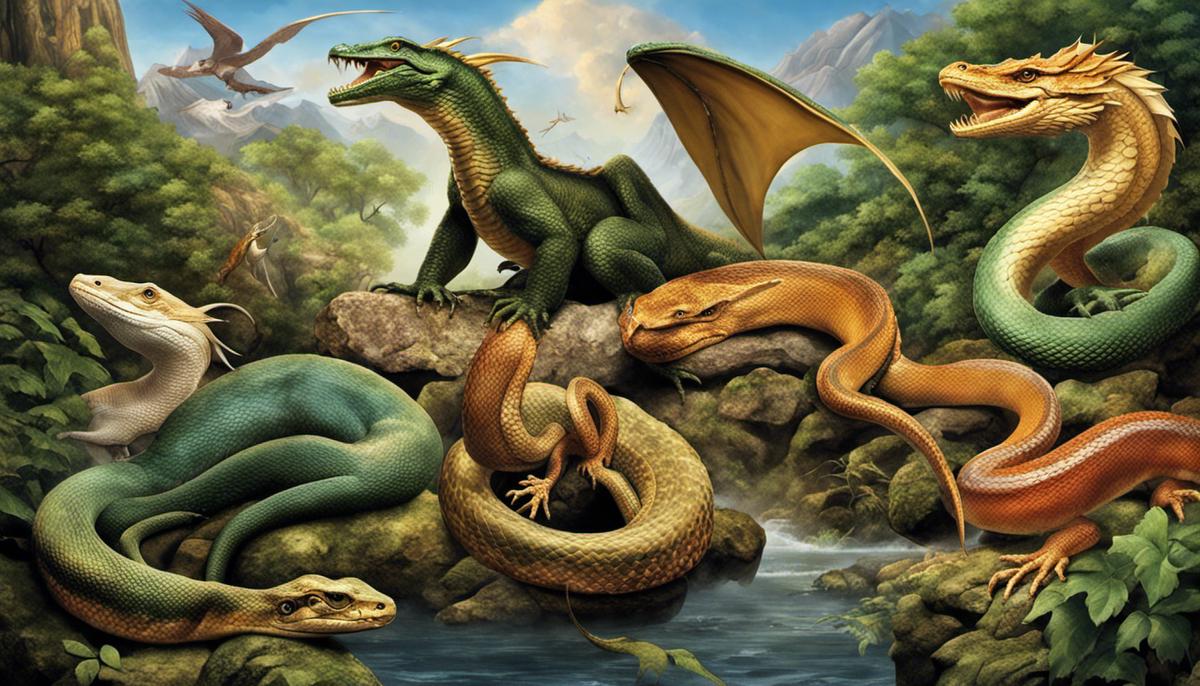
Popular reptile myths and legends worldwide
Busting Reptilian Myths and Legends: A Worldwide Exploration
If there’s one thing we reptile enthusiasts can agree on, it’s that our scaly friends are undeniably fascinating. While modern science should have dispelled antiquated misconceptions about reptiles, numerous myths and legends still abound, with many being believed as absolute truths. A fulfilling journey into the world of reptiles isn’t complete, if we do not explore these delightful yet misconstrued tales.
Let’s dive into a few of the most widespread reptile myths and legends from around the globe. Each has its intriguing elements and cultural connotations, providing us an understanding into the depths of human imagination.
Navigating to the African continent, we note a prevalent myth in Nigeria concerning the python. Locals believe that this creature is an embodiment of a river spirit. Killing a python is considered a grave offence, and offenders are traditionally required to give the deceased python a full burial, akin to a human funeral.
Flying across to Mexico, we encounter the Quetzalcoatl, yet another incredible legend. Quetzalcoatl, the Feathered Serpent, was a prominent deity in ancient Mesoamerican culture with the duality of being both a creator and a destroyer. This myth illustrates the recurring theme of reptiles as symbols of life, death, and rebirth.
The legend of the Rainbow Serpent is an indelible part of the Aboriginal cultural landscape in Australia. It is believed to shape landscapes, creating rivers and mountains, as it moves through the earth. A symbol of fertility and life-giving rain, it indeed reflects the indigenous people’s intimate connection with nature.
In ancient Japan, it was common to find legends related to the Kappa, a humanoid creature with reptilian features. The Kappa is believed to inhabit rivers and lakes, often being blamed for drowning accidents. Despite its infamy, it is said that they treasure etiquette, providing a way to safely interact with this mythological creature.
Drawing closer to home, we find plenty of American folklore where reptiles play major roles. Native American lore, for example, frequently cites the turtle as a symbol of wisdom and longevity. Consider the creation story of the world resting on the Great Turtle’s back, highlighting the veneration and respect accorded to turtles.
Now, let’s debunk a few general reptile myths: reptile skin isn’t slimy; they do not possess supernatural strength and no, not all reptiles lay eggs. These are just a few common misconceptions that even aspiring herpetologists tend to harbor.
So there you have it, a global romp through the captivating world of reptile myths and legends. Everywhere you go, you’re likely to encounter a unique tale or belief surrounding these intriguing creatures. While we’ve certainly come far in understanding the realities about reptiles, taking a moment to appreciate these traditional stories can certainly enrich our perception. After all, in each tale or myth, you discover yet another facet of humanity’s enduring fascination with these scale-clad creatures.
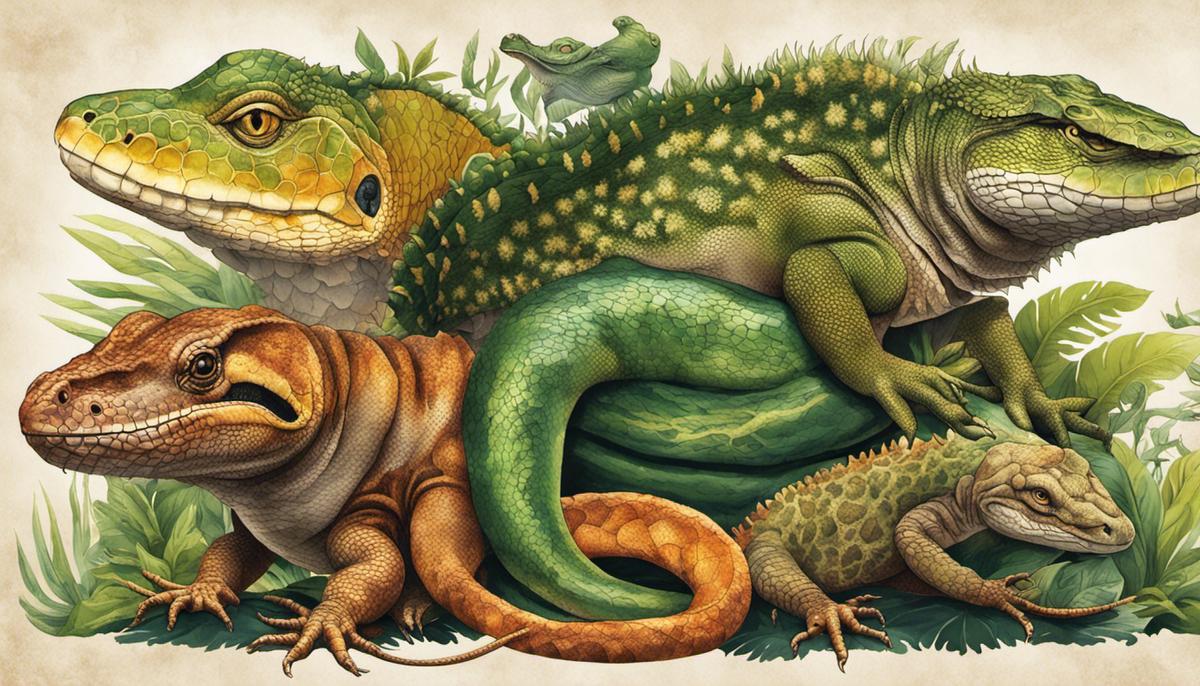
Interpretations and meanings
Venturing into the realm of myths and legends that illuminate the significance of reptiles, it’s impossible not to be intrigued by the deeper meanings these fantastic creatures reveal in cultures across the globe. Following the trail of stories we find ourselves lumbered with mystique, culture, and a realization that transforms our understanding of reptiles; from merely scaly creatures to wondrous, symbolic beasts.
Mesoamerica boasts the legend of the Iguana Girl, a tale spun in Costa Rica. The protagonist, an iguana, embodies aspects of femininity, beauty, and ultimately, transformation; that resonates with the reptile’s ability to unease skin, symbolizing growth and renewal. This legend beautifully merges folkloric narratives with astute observations about natural life, creating a tantalizing blend of knowledge and mysticism surrounding reptiles.
Over in the Maori mythology of New Zealand, the Tuatara, a reptile remarkable for its third eye, has long been considered a representation of wisdom and insight. This unique creature has been renowned to symbolize the capability to perceive beyond the conventional realm, providing an enlightening perspective of how old cultures interpreted complex ideas like awareness and perception using the characteristics of reptiles.
Travel towards Africa, and we encounter the tale of Mamlambo, described in Zulu folklore as a large serpent reminiscent of Greek Hydra. Ascribed with the ability to control water and storms, Mamlambo exists as a symbol of nature’s mighty and untamed power. She signifies respect for the power of nature and humankind’s fragility, intertwined and made understandable through imagery of the awe-inspiring reptile.
Moving across the ocean to the Mayans of Central America, we encounter the awe-inspiring vision of the Vision Serpent. This spectacular creature, usually depicted with a single eye, signifies the gateway to the spiritual world. The Vision Serpent was believed to bridge the gap between the mortal and heavenly realms, making it not just a reptilian creature, but an entity brimming with spiritual significance.
Lastly, let’s consider the Greek Medusa, a figure synonymous with terror and fascination. Interestingly, her snake-spat hair isn’t just for theatrics. Geometrically, snakes exist in a seemingly infinite number of contorted shapes, representing the infinite potential for transformation. In an oddly optimistic turn, Medusa‘s snake-studded head symbolizes adaptability and change.
Reptiles, in essence, are more than exquisite creatures that bask in the sun and display a variety of vibrant colors. They represent a deep well of symbolic meanings that have been embedded into the fabric of various world cultures. These myths and interpretations are evidence of how reptiles have shaped our understanding, and continue to illustrate universal concepts like transformation, wisdom, power, spiritual connection, and adaptability. As the exploration into these fascinating beings continue, every scale unturned is a revelation about the spectacular roles reptiles have played, and continue to play, in human culture and mythology.
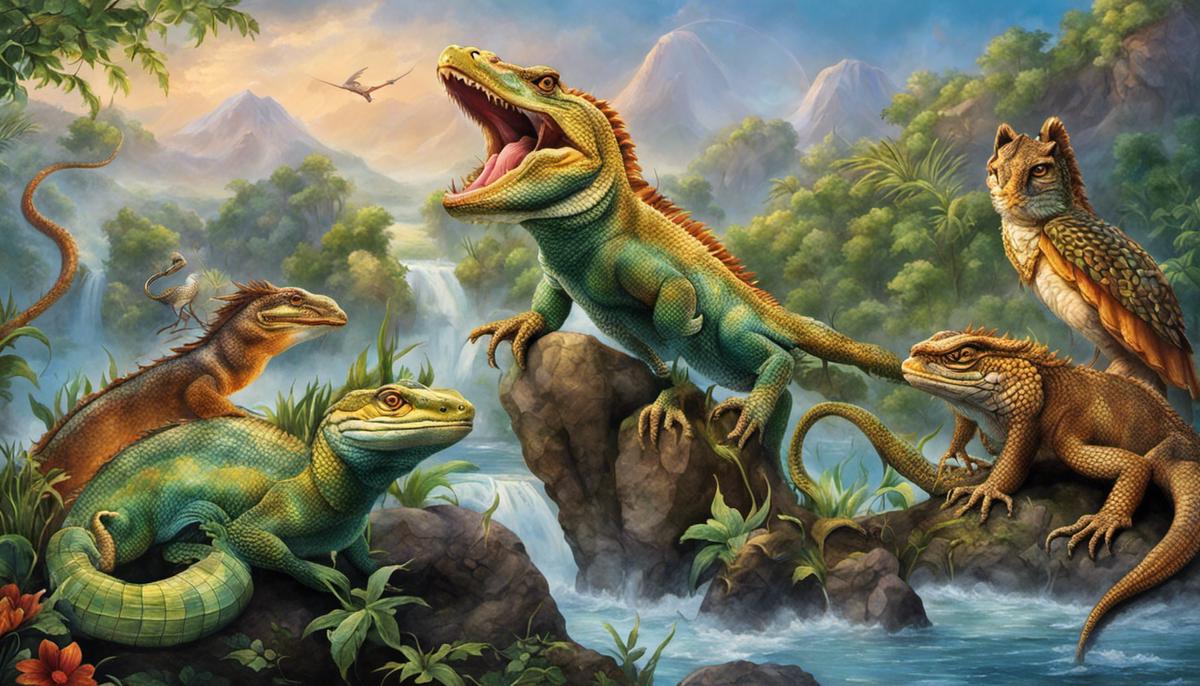
Impact on modern culture
Having made our journey through the global anthology of reptile legends, it’s easy to see the ripples these ancient tales have made in our modern cultural fabric. These mythical creatures are part and parcel of our heritage, identity, and collective consciousness, and they continue to fascinate and influence us today.
Moving from older tales to current story arcs, let’s delve into the world of popular culture. Who can overlook the monstrous reptiles of the cinematic Jurassic Park fame, etching into our minds, the archaic and magnificent age of the dinosaurs? Or the teenage mutant ninja turtles who fight crime in the sewers of New York City, advocating for courage, teamwork, and honor?
Cross the realm into literature, and it’s impossible not to recognize the pivotal role of reptiles from Nagini in Harry Potter to Smaug in The Hobbit. We can clearly see how storytelling has evolved the perception of these creatures from their mythological roots to their contemporary, often less menacing, depictions.
Exploring the domains of fashion and design, snake motifs, croc textures, and other reptilian elements offer an exotic, standout appeal. Renowned fashion houses like Gucci, Versace, and Bvlgari prominently feature serpent motifs in their collections, embodying power, wisdom, and transformation.
Stepping into the world of music, one can’t help but think of Rock ‘n’ Roll’s iconic bad boy, Jim Morrison, famously known as the ‘Lizard King’. In modern EDM culture, artists like ‘Rezz’ carry the torch, cultivating an image that combines techno-futurism with reptilian symbolism.
Pull up a browser, and you’ll find the Internet abuzz with viral reptile content. From amusing memes featuring iguanas to viral videos of baby turtles and passionate communities of reptile hobbyists, digital connectivity has amplified our love for these diverse creatures.
Considered totem animals in many cultures, reptiles have steadily made their way into contemporary branding, logos, and mascots. Think of Lacoste’s iconic crocodile, or the London Zoo’s unforgettable logo, emphasizing character attributes like longevity, adaptability, and resilience.
These reptilian legends, myths, and symbolism carry a modern resonance that transcends time. In essence, the ancient perceptions toward these creatures have not been replaced but repurposed, and remolded to echo in our current zeitgeist.
Our fascination with the reptilian world shapes how we engage with everything from literature and the arts, urban legends, movies, fashion, music, digital content, branding, and even our everyday conversations. It’s a testament to the human imagination and our innate ability to recast these cold-blooded companions into warm-blooded narratives that continue to charm, inspire, and engage us in the modern age.
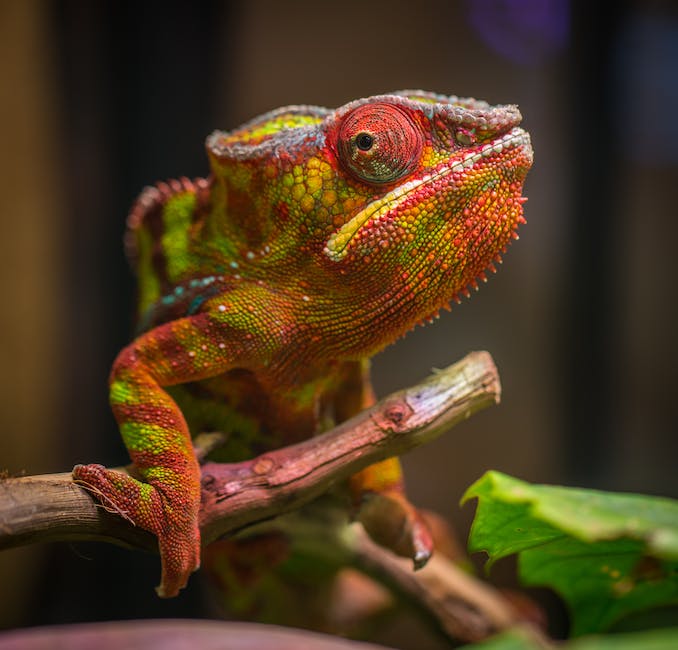
Debunking the myths
After having indulged ourselves in the compelling world of reptile myths and legends, it’s time to take off the mythical metaphorical cap and don the scientific one. Just as legends could portray reptiles in a multitude of ways, scientific facts are equally manifold and fascinating. It is in this comparison of fact and myth, of reality and folklore, that the very essence of the marvel of reptiles emerges.
Science
tells us that there are over 10,000 species of reptiles on our planet. From the tiny Borneo earless monitor, the smallest lizards in the world, to the magnificent Komodo dragons, the largest living lizard species, reptiles are a vastly varied group of animals. They inhabit all continents except Antarctica and boast an impressive diversity of forms and behaviors. Yet, their portrayal in mythology and folklore often focuses on just a few species or generalizes entire species.
- Let’s zoom in on the world of snakes.
Medusa, a figure from Greek mythology, is often depicted with snakes in place of hair, regarded with fear and repulsion. Scientifically, snakes are remarkable creatures, despite the common phobia they invoke. While myths might portray them as monstrous beings, some species are critically important for maintaining a balanced ecosystem, controlling rodent populations, and even helping to develop potent medical treatments from their venom.
- Now to dragons –
while they are ubiquitous in mythologies worldwide, our beloved fire-breathing giants do not exist in reality. However, the Komodo dragons of Indonesia are a good fit for the dragon moniker. These real-life dragons don’t breathe fire, but they do have a venomous bite and can reach lengths of up to ten feet [3 meters]!
- When it comes to sea turtles,
portrayed as wise sages in many Native American legends, science indeed confirms their longevity. With some tortoise species such as Aldabra giant tortoise known to live beyond 200 years, these creatures are among the earth’s most enduring inhabitants. They don’t possess mystical wisdom, but their migratory patterns and navigational skills are quite awe-inspiring.
- Another shining example would be the crocodile.
Universally feared and revered in ancient mythology, modern science recognizes them as one of nature’s most successful survivors, virtually unchanged for over 200 million years, outliving dinosaurs!
While myths and legends often place reptiles at the center of supernatural narratives, science frames them as survivors, integral parts of our ecosystem, and bearers of biological wonders. Reptiles’ portrayal may differ between science and mythology, but both arenas highlight the fascination these creatures hold for humanity. Separating scientific fact from myth and legend helps develop a mature understanding and inspire a deeper appreciation of these truly amazing creatures.
The contrast between reptile science and folklore illuminates the path to a more balanced perspective on these incredible animals. Through the varied optics of culture, legend, and science, we see reptiles as more than just the subjects of our stories or studies. They are an integral part of our world, deserving of admiration, respect, and conservation efforts. Understanding is the first step to conservation. Thus, strive to learn more, share more, myth or reality, because every bit counts in securing the future of our scaly friends.

Photo by jeremybishop on Unsplash
As we step back and look at these tales through the lens of rationality and scientific understanding, we discover that our perceptions of reptiles have been dramatically skewed by centuries-old folklore. Our insights culminate in an unmasked appreciation of these intriguing creatures, debunking the myths enveloping them, and we realize the importance of separating fact from fiction. We come to understand that the symbolic representations of reptiles in ancient tales or modern narratives are born out of our imagination rather than biological reality. Yet, there’s no denying that these myths and legends continue to fuel our fascination for these distinctive creatures and remain an integral part of our cultural DNA.

